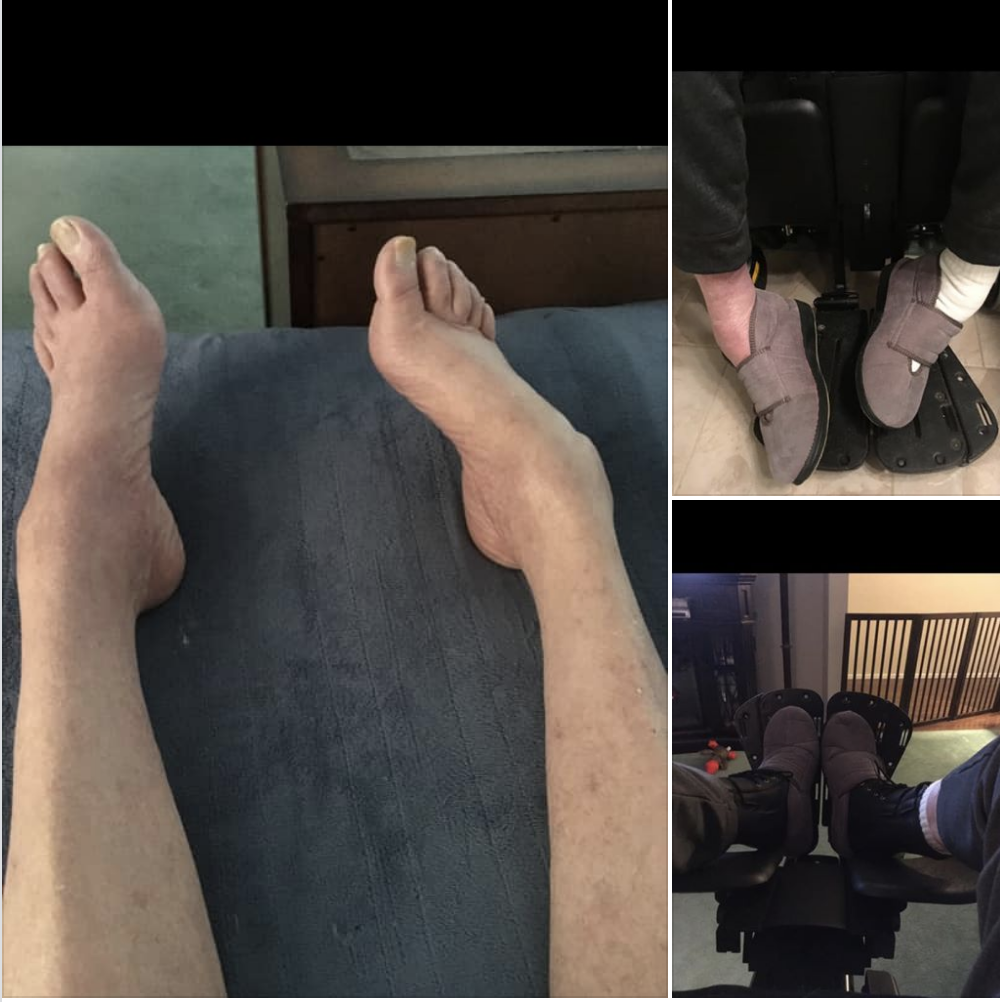
Print or print to save as PDF.
Webpage Menu:
⚁ 7.1 Introduction.
⚁ 7.2 Transportation.
⚁ 7.3 Wheelchairs.
⚁ 7.4 Bathroom.
⚁ 7.5 Bedroom.
⚁ 7.6 Kitchen.
⚁ 7.7 Computer.
⚁ 7.1 Introduction:
⚂ 7.1.1 Everyone is different!
It is very important to realize that each patient presents unique
challenges and situations and no two patients are exactly alike.
≻ There are no right or wrong ways to deal with these issues,
although the priority must be on safety.
≻ It has been my experience that patients will often take tremendous
risks because they are literally stubborn and do not want to accept the
fact that they need extra help - I should know I was a prime example.
≻ I consider myself quite lucky that in the number of falls I had, I
was never
seriously
injured although I knocked myself out once, broke an ankle and received a
70 stitch cut under my elbow – I could just as easily have broken my
neck.
≻ So, my primary message is, whatever you do to adapt, adapt at the
right time with the right strategy to maximize safety and minimize the
risk of further injury.
≻ Jim Kirkpatrick was almost killed in a fall in his shower when he
fell down onto his knee and it came up into his abdomen injuring his
spleen.
There is a tremendous variety of wheelchair and other handicapped
equipment available.
≻ Sadly, handicapped services and equipment are very poorly
regulated and in many cases, patients are sold expensive equipment that is
not suitable for their medical situation.
≻ This is the ultimate example of “consumer beware.”
≻ Although all handicapped equipment is very expensive, Internet
searches can often reveal used equipment that is very suitable.
⚁ 7.2. Transportation:
The major concern of transportation is practicality and safety.
≻ Whatever equipment is used, for example, a handicapped modified
Van needs to be well suited to be needs of the individual.
≻ Individuals with progressive conditions need to take this into
consideration as their abilities and needs will change over time, your
abilities and needs today will change as IBM progresses.
A typical side entry van is pictured below.
≻ There are many configurations available for these vans.
≻ Typically, the two front seats are removable and the wheelchair
can fit behind the steering wheel (if the person in the wheelchair can
drive) or on the passenger side.
≻ Also, a wheelchair could fit in behind the driver's seat or behind
the passenger seat.
≻ Alternatively, two wheelchairs could be accommodated.
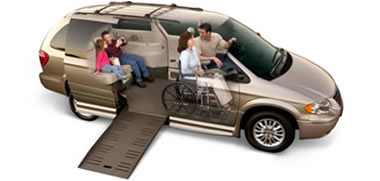


A typical rear entry van is pictured below.
≻ These vans do not offer as much flexibility in configuration.
≻ The wheelchair fits behind the front seats in the middle of the
van.
≻ These vans are often used as taxicabs.
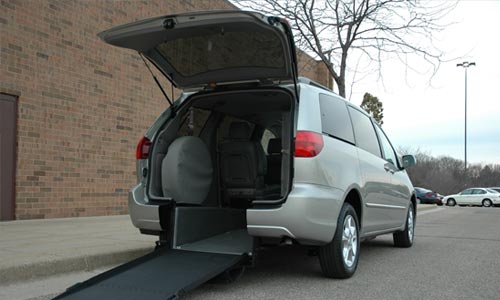
There are many different arrangements for strapping the wheelchair down.
≻ Normally, the floor of the van will have attachment points, and
the wheelchair will have optional tie-down attachment points, one on each
corner.
≻ The cheapest system is to have four belts that are manually
tightened.
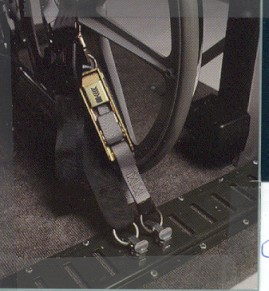
Another particularly easy system is the
Q straint.
≻ In this system, the belts are self-adjusting.

An important option on wheelchairs is to have tie-down attachments.
≻ These consist of four metal attachment points, one on each corner,
where the wheelchair can be restrained.
≻ Even if you don't use a handicapped van it's important to have
these tie-downs for a couple of reasons.
≻ One, you may find yourself in a handicapped taxi or bus which will
require restraint attachment points.
≻ Second, I loop a foot long 1 inch wide nylon belt around each
tie-down allowing someone pull or lift the chair – a very convenient
feature when the chair becomes stuck or when it has to be lifted.
A very handy device is the
EZ lock.
≻ This is a plate that fits onto the floor, the wheelchair has a
hook underneath and clips into place.
≻ This has the advantage that the attendant does not have to strap
the wheelchair down, this electric lock system holds the chair firmly in
place.
≻ It is also crash tested and provides good safety when used in
combination with a seatbelt.

The picture below illustrates a number of points.
≻ Normally, the seatbelt is part of the seat assembly, with the
passenger seat removed, a new attachment point has to be provided.
≻ The removable drivers seat is visible with the seatbelt stem for
the passenger seat belt (A) clipped into the floor railing (F) with a
seatbelt extender attached (B).
≻ You can see where the electronics of the seat plugs into the van
at point G.
≻ A Q-straint retractor is visible at point C.
≻ You can also see the left railing where the passenger seat would
attach to the floor (D) and you can see the edge of the EZ lock (E).
≻ In this configuration, the wheelchair sits beside the driver's
seat and is restrained by the lock on the floor and by the seatbelt using
the extender to go around the chair and person.
≻ In this example, the floor of the van has been lowered some 10
inches to accommodate a wheelchair.
≻ This is handy because the van will still fit into a normal garage.
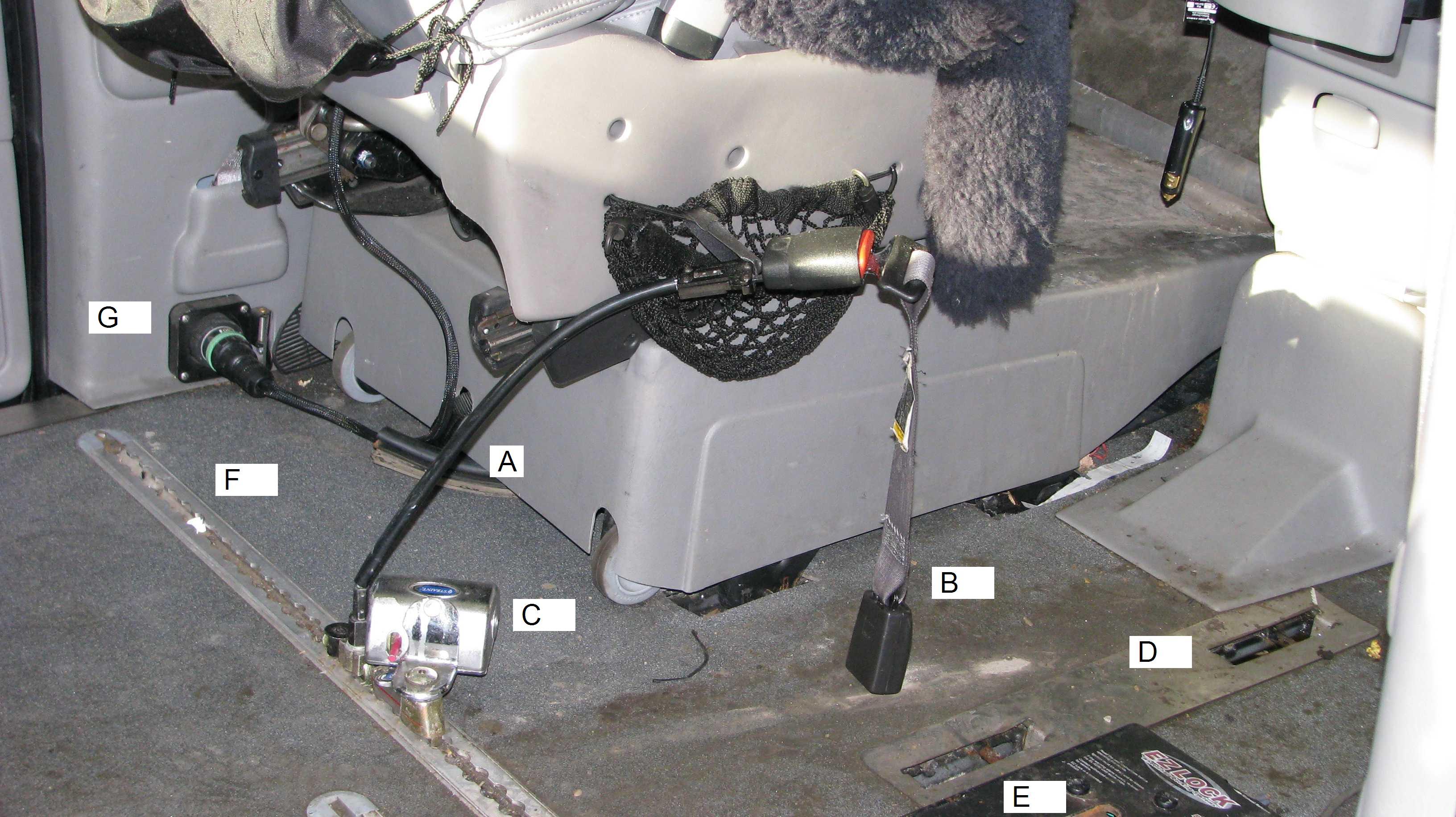
The floor of the van will have attachment points, in the following
picture, illustrated with four q straint buckles attached.
≻ In some cases, the ceiling of the van is raised to accommodate the
chair, this has the disadvantage that the van is usually too high to fit
into a normal garage.

There are a number of different configurations for left hand control of
acceleration and braking.
≻ These controls can sometimes be used for IBM patients while their
arm strength permits.
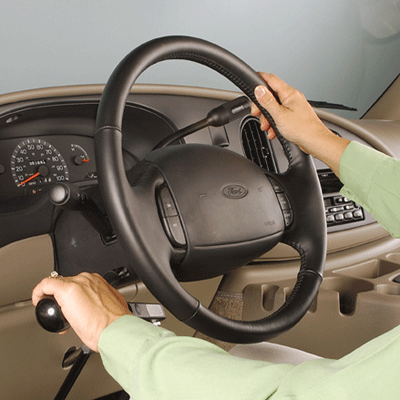
Transfers need to be adapted to the persons' requirements.
≻ For example, individuals with muscle disorders or individuals with
frail bones cannot be physically lifted the same way a normal person could
be assisted.
≻ The use of slings may be necessary, particularly when transferring
in awkward situations, for example, getting on and off an aircraft.
≻ Usually, the airline uses an ordinary manual wheelchair to move
the person through security and to the door of the airplane.
≻ At that point, airline personnel lift the person onto a narrow
chair and essentially carry the chair and person into the plane and down
the aisle.
≻ The black straps illustrated below are seatbelts.

⚁ 7.3. Issues related to wheelchairs:
There are many different kinds of wheelchairs and consumers must be very
informed when purchasing this kind of equipment.
≻ Generally speaking, scooters are not advised because they have a
number of drawbacks – primarily their lack of customizability in
seating and their poor durability.
≻ As well, many scooters are not as stable as a power wheelchair, in
particular three wheeled scooters are quite unstable and dangerous.
IBM patients need to realize that we have a progressive ongoing disorder.
≻ Once we need a wheelchair, we will need a wheelchair for the rest
of our lives.
≻ Therefore, it is more important than ever to make the right
choices early on so that you do not buy equipment that may be appropriate
today but in a year from now may not work for you.
Most stores have demonstrator models that you can drive for a few days to
test out.
≻ There are different kinds of configurations, some chairs have the
drive wheels in the middle, some have them at the back and this makes
quite a difference to the way they turn and handle.
≻ Part of this choice is personal preference.
≻ Again, in order to pick the appropriate type of chair, you may
need to try out several before deciding on the one you need.
Choices are based upon factors such as your size and weight as well of
your needs.
≻ The newer power chairs are extremely mobile although at first you
feel like you're driving a riding lawnmower in your house, as you learn
how to use the machine it becomes easy to maneuver in tight situations.
≻ An example of a basic chair is shown below (this one is front
wheel drive – the big driving wheel is at the front of the chair).
≻ These generally come with the joystick that controls them.
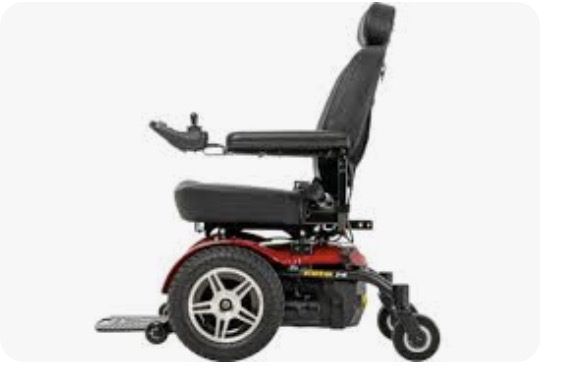
Today, there are many choices available in terms of tilting, reclining,
standing up and raising.
≻ The seat is important because you are eventually going to be
spending a great deal of time sitting in one position.
≻ Therefore, the most critical thing is that the seat is custom
measured to get the exact dimensions required.
≻ These measurements include the distance from your foot to your
knee, from the knee to the back of your seat, and how high your arms
should sit.
≻ Ideally, these measurements will be made by an occupational
therapist in conjunction with the store selling the wheelchair.
≻ This makes a huge difference in one's day-to-day comfort.
A feature useful for men is a stander (this facilitates urination).
≻ This feature is pictured below.
≻ There is a brace in the front that holds your knees in while the
chair raises.
≻ Although not shown in this picture, you would have a seat belt
going around you to prevent falling forward.
≻ Most chairs can move around while standing making this a
particularly advantageous system.
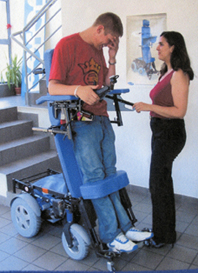
Wheelchairs specialized for recreation are available.
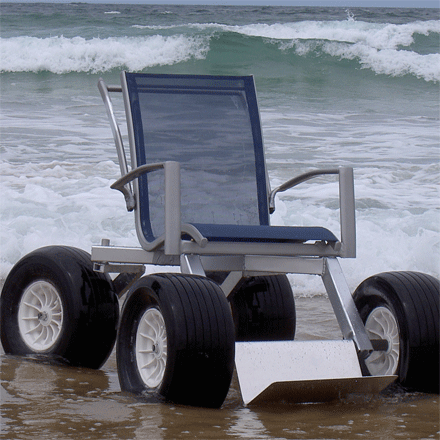
The seat cushion is the next critical component.
≻ Generally speaking, these cushions have some sort of air pockets
with a thin cover on top as shown in the picture below.

There are a number of things you can do to assist when using a wheelchair
in the house.
≻ For example, if possible removing doors creates more space in
coming in and out of a room.
≻ On some doors, especially front doors of older houses, the use of
offset hinges may be very helpful.
Individuals who must sit for long periods of time in wheelchairs need to be particularly aware of issues related to skin.
The four major enemies of skin are prolonged exposure to:
Skin breakdown is a critical aspect of mobility problems.
≻ It is surprising how fast skin can deteriorate (in hours).
≻ It is particularly important to avoid sitting for long periods of
time with moisture or when creases in clothing create pressure on the
skin.
≻ Initially the skin will blister and breaks in the skin tend to be
very difficult to deal with, especially on the buttocks or behind the
knees where they usually occur.
≻ Also, people who have mobility challenges may have difficulty
turning over in bed and thus present a risk for developing pressure sores
while sleeping.
Appropriate ramps or elevators are usually necessary in order to adapt a
house to a wheelchair.
≻ There are wide variety of systems available, for example, a common
portable aluminum ramp is illustrated below.

A common problem, rolling over of the ankles, seen in long term wheelchair
use and IBM. (below).
≻ Bottom right with velcro braces.

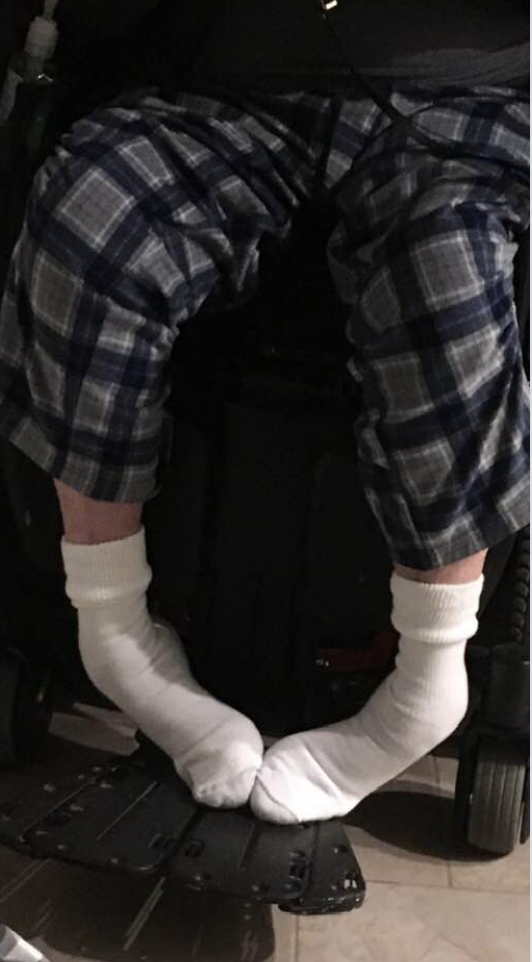
⚁ 7.4. Bathroom:
For a person with a mobility issue, the bathroom is probably the most
dangerous room the house.
≻ Transfers on and off the toilet and using a shower or bathtub pose
high risks for falling.
≻ Again, the individuals particular needs must to be considered in
designing a plan that is both practical and safe.
≻ Unfortunately, many people are shy and reluctant to accept
assistance in the bathroom and this often leads to major problems.
≻ When vanity meets safety, safety must win.
One piece of equipment that is useful for transfers is a sit to stand
machine as pictured below and in use.
≻ These machines must be used with an assistant.
≻ From a sitting position (for example, on the edge of the bed) this
machine uses a strap that goes around the back to lift the patient.
≻ The patient faces the machine and his or her knees are braced.
≻ The patient can easily be lowered onto the toilet or onto a
wheelchair or other type of chair or couch.
≻ One advantage here is that the patient who cannot stand unassisted
can still use this type of system and weight bear on their legs.
≻ The patient hangs onto the bars for balance but no strength is
required, the electric/hydraulic machine provides all the power necessary.
≻ When used correctly, these devices are very safe.



Another very common lift often seen in hospitals is called a
hoyer lift
as pictured below.
≻ In this system, the patient swings freely in the sling.
≻ These slings are quite variable but generally consist of two or
three straps that are placed around a person who is either lying or
sitting, these straps then attach to the lifter.
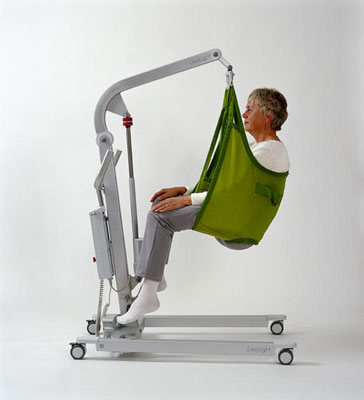
There are many different kinds of devices and configurations to assist IBM
patient with the toilet.
≻ Generally, you will need to adjust the height of the seat as your
illness progresses.
≻ The following picture is a typical setup.

For people having trouble standing up there is there is a power assist seat lifter as illustrated below.
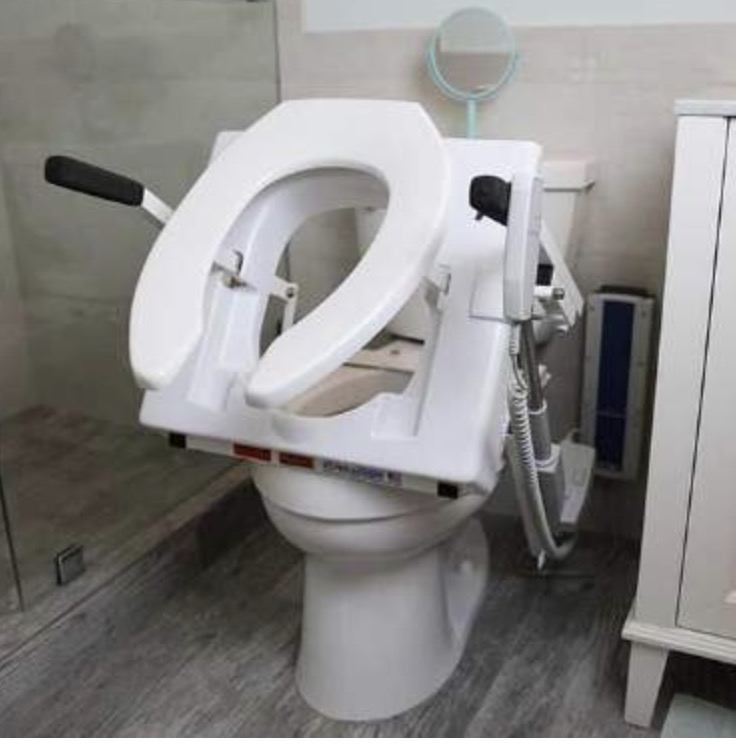
There are also many different configurations for the bathtub and shower.
≻ A simple plastic shower chair can be quite useful and can be used
either in the shower stall or in the bathtub itself (as illustrated in the
picture below).
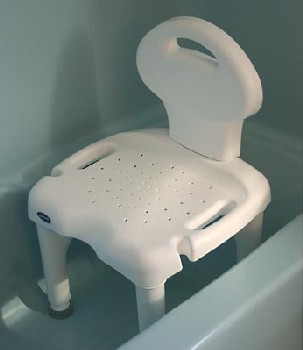
There is also a style of chair with wheels that can be moved in and out of an accessible shower stall by an assistant, as pictured below.
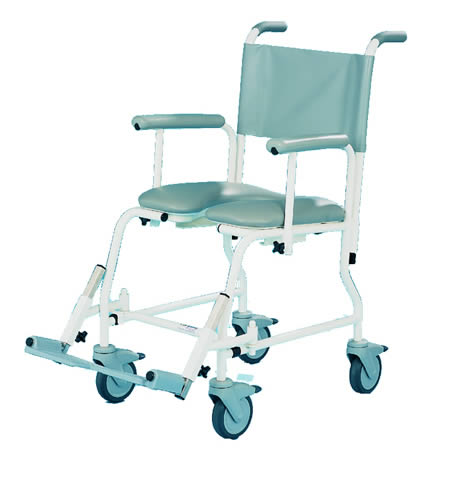
There are also a wide range of devices designed to assist a person moving
in and out of the bathtub.
≻ Generally speaking the patient with IBM needs to be very careful
when using handgrips or railings because if you start to fall you are
unlikely to have enough strength in your arms to hold yourself up even if
you are holding onto a suitable handrailing.

⚁ 7.5. Bedroom:
Transferring in and out of bed can be a major issue.
≻ To address this, the best solution is some sort of lift system.
≻ These systems typically consist of three components; a battery
operated lifter, a sling that goes around the patient and a track system
on the ceiling.
≻ Portable track systems can also be purchased (as shown in the
first picture).
≻ These lifts are very versatile as they can be moved from room to
room – for example, you would have track over the bed and another
track over the toilet/bath.

This picture shows a handle at the top of the strap (out of 45° angle) that is used to move the lifter on and off the hook on the track.

Here is a typical sling configuration.
≻ The two flaps at the bottom go under one's thighs, the two straps
at the top go over one's shoulders.
≻ The three blue straps in the middle are handles for the assistant
to use to help maneuver the patient.

In the following picture, the overhead track and the sling can be seen in
use.
≻ In this system pictured, the track and lifter are a permanent set
up, in this case, over an indoor hot tub.
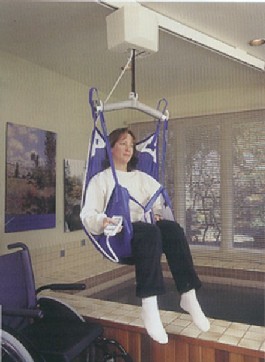
There are many different methods to create a softer sleeping surface.
≻ The following picture illustrates a specialized air cushion type
mattress topper (gray in the picture) that is highly effective (but
expensive).

Another alternative is to use a hospital style inflatable mattress.
≻ These are usually controlled by a unit blowing air into the
mattress and they can be adjusted in terms of firmness.
≻ These are probably the best alternative but the drawback is that
they are very expensive.

⚁ 7.6. Kitchen:
Patients with IBM often have difficulty eating due to weakness in the arms
and hands.
≻ A bent spoon with a handle made from foam cut from inexpensive
pipe insulation available at the hardware store.
≻ They can be rolled up tightly and stuck together because they have
adhesive edges to secure pipes.
≻ These also work with plastic tableware because they are extremely
lightweight. Contributed by Diana.

Another alternative
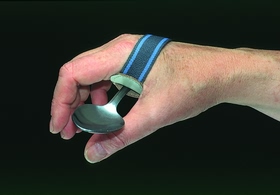
Another alternative

⚁ 7.7. Computer:
A voice recognition program like Dragon speaking is very useful when a
user's hands make a keyboard impractical.
≻ There are a couple of aspects to take into consideration,
primarily the RAM of the computer.
≻ The second critical aspect is the microphone, these programs take
a little getting used to but again can be very helpful.
Another useful program is an on-screen keyboard. Most operating systems now have one built in.